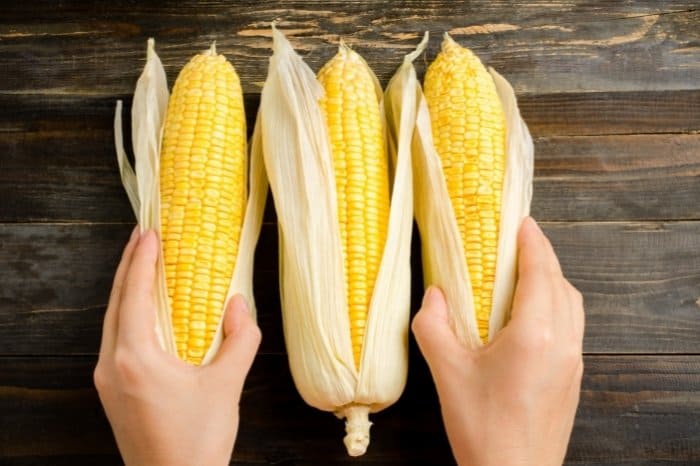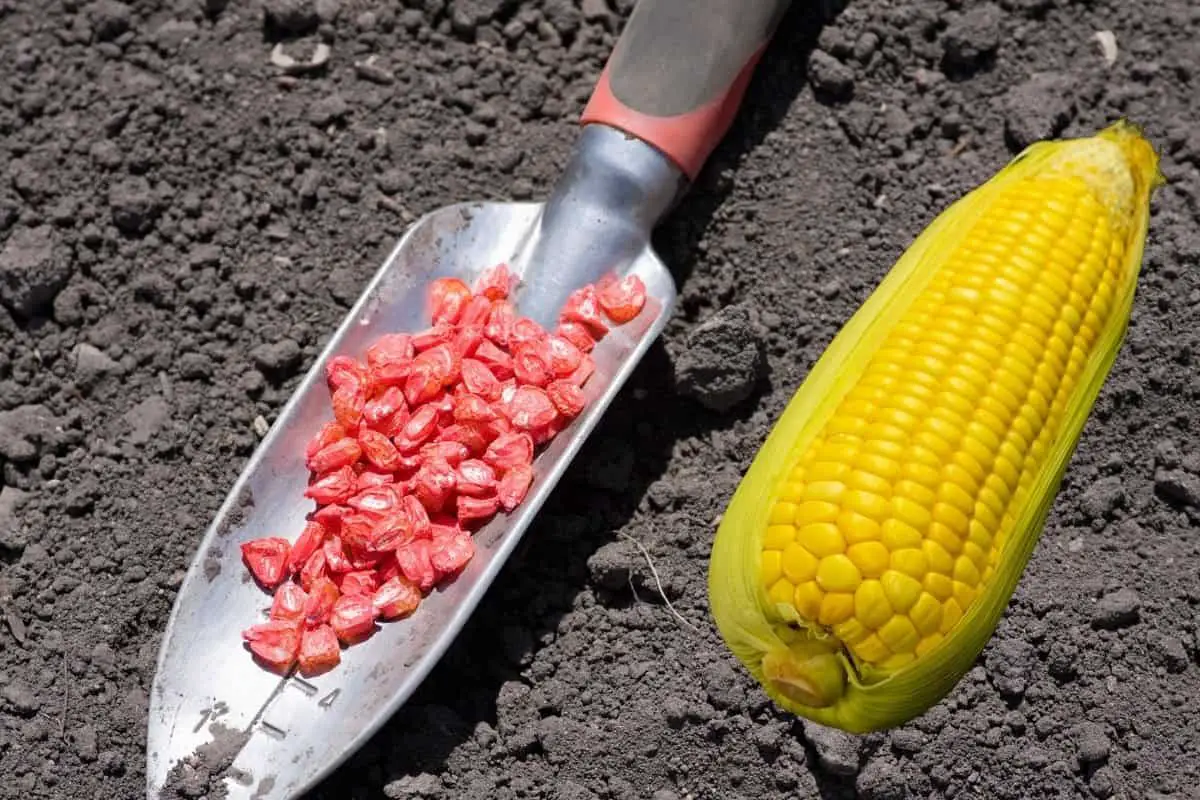Last Updated on February 10, 2022 by
Sweet corn is a popular vegetable among Americans; did you know you could grow your own if you learn how far apart to plant sweet corn?
Sweet corn is used to bring colour and flavour to summertime barbecues, indoor dining and picnics. It is easy to grow and among the most grown crop in New England.
The average production for a home garden is about 1-2 ears per plant. You will find it growing in home gardens across the USDA plant hardiness zones 3 to 11. The Zea Mays (corn) sweetness levels differ according to the variety grown.
When growing white, yellow or hybrid sweet corn in your home garden, you should know the correct sweet corn spacing required in your available space.
Types Of Sweet Corn You Can Plant
Sweet corn ears come in various colours – yellow, white or bicolour (a mixture of white and yellow kernels. The bicolour varieties are common in New England.
All these varieties are excellent, and the harvest depends on the specific variety, the growing conditions, and personal preference.
- Sweet corn kernels are much loved and sweeter than field corn varieties because of their mutation at the sugary locus. After harvesting the corn, the sugar changes into starches, and the kernels grow tougher and less sweet.
- The old (su) sweet corn varieties grow starchy very quickly after harvest, the reason why you must use them immediately. That’s why the traditional recommendation to get the pot of water boiling before harvesting the corn is still followed today.
- The Sugary-enhanced varieties (se or se+) varieties have more sugar than the (su) varieties, and the super-sweet (sh2) varieties are the sweetest of all.

These varieties have their sugars converting to starches much slower than the other types. If the super-sweet varieties cross-pollinate with other types of corn, the quality of both is reduced.
You can prevent cross-pollination by planting each type far away from each other against the wind direction, alternatively, by planting different varieties on spaced out dates, so they do not bloom at the same time.
How Far Apart To Plant Corn
Corn should be spaced accordingly to enable the plants to bear a good yield. The rows should be spaced at least 2½ – 3 feet apart. The plants should be spaced at least 8-10 inches apart from plant to plant.
Early planted sweet corn seeds should not be buried more than 1 inch deep. Later planting, the seeds should be at least 1 to 2 inches deep to ensure adequate moisture contact.
Once the sweet corn is ready for harvesting, it will only remain mature for a short time, about 7 to 10 days; to get a continuous harvest all through summer, plant a small number of sweet corn varieties with different dates to maturity.
Grwing Sweet Corn
Growing sweet corn is straightforward. You only need to know the basics of the right growing conditions and the critical sweet corn seed spacing. Let’s look at the conditions required to grow this vegetable.
Sunlight
Sweet corn should receive full sun for maximum growth and yield. The soil temperature should be at least 50 degrees F, but 60 to 85 degrees F is best to facilitate germination and growth. Even though germinated sweet corn can withstand light frosts, ensuring the soil is warm enough to allow germination is important.
Seeding and Transplanting
You can seed your sweet corn directly in your garden, but this must be done in spring when the soil is warm enough.
You can start them indoors and transplant them outdoors within 10 to 14 days of seeding for transplants. For transplants, sow your seeds in cells that are large enough to prevent them from becoming root-bound.
Soil
The best soil for sweet corn is rich, well-drained soil with a pH of 6.0 to 6.8. If you have these options, plant early corn in light soil – sandy or loam and later varieties in heavier soil – silt or clay. If not, go ahead and plant your corn in your type of soil.
Light soils are best because they warm up faster from the frost than heavier soils and causes germination to happen more readily. In a hot mid-summer climate, the heavier soils have the advantage of holding more moisture than the lighter soils.
MOTHER EARTH Coco Plus Perlite Mix – For Indoor and Outdoor Container Gardens
Watering
Sweet corn requires plenty of water from germination to harvest; however, the most critical period for watering is 2 weeks before the silks form.
Target to water at least 1 inch of water each week; supplement your watering with natural rainfall or irrigation as needed.
Pollination
Corn must be pollinated to bear their crop. Pollination is necessary because each kernel develops only after pollen grain land on the silk attached to that kernel.
They are pollinated when the wind currents carry the pollen from the tassel to the silk. Corn can pollinate effectively even when planted in a single row. Planting several of these rows in a block formation provides the right atmosphere for successful pollination.
Fertilization
If you have aged manure or compost manure, use it to fertilize your soil before planting. It provides your soil with nutrients and increases water-holding capacity. Test your soil before planting to determine the amount of fertilizer and lime needed.
Corn requires an equivalent of 25lbs of 10-10-10 fertilizer per 1,000 square feet. You can use equivalent rates of other organic or synthetic fertilizers instead of 10-10-10.
Thoroughly incorporate your choice of fertilizer in the soil before planting to get the best effect. You can side dress your sweet corn when it reaches about 15 to 18” high using at least 2.5lbs per 100mof 10% nitrogen fertilizer or the equivalent. . Spread this fertilizer on either of the sides of a single row or between the rows.

FAQs
Can you plant corn too close together?
1. If your corn was planted in rows, then you need to space the seedlings out more than they were planted in rows. I'd say at least 3-4 inches between rows. This is for 2 reasons:
2. you don't want the rows to get too close together, because that would cause problems with moisture retention and also cause them to grow into each other; and
3. it will allow for better air flow and moisture retention. I have never seen any problems with planting corn too close together. It's just like when you plant vegetables in a row.
The spacing between rows is determined by the width of the rows themselves. You can't plant them too far apart, or they'll interfere with each other. Corn is one of the easiest crops to harvest once it's ready, but it can be tricky to get it out of the ground and into your cart at the same time.
Here are a few things to keep in mind:
1. Be sure to use a sturdy pole or tree branch to help you pull the corn out of the ground. A fork or a trowel will not work. You need something that is strong enough to hold the weight of the corn while you're pulling it out. If you don't have a sturdy pole or tree branch, you can use a stick or the edge of your shovel.
2. The first ear should always come out first. This way, you won't have to worry about the other ears getting caught on the ground.
3. Pull the corn out slowly. It is easier to pull out a single ear at a time than to try to do them all at once.
4. Once you've got the ears out of the ground, lay them flat on the ground and cut the silk off with a sharp knife.
5. Don't bother to try to husk the corn. The husks just get in the way when you're loading it into your cart.
Can you plant corn in the same place each year?
Yes, you can grow corn in the same place in your garden every year. The corn is a warm-weather crop that needs full sun to grow. It doesn't tolerate frost and should be planted after all danger of freezing has passed. Corn is a hardy crop and can be planted in March or April. You can also plant a fall crop of corn by sowing in August and planting in September.
How do you keep worms out of sweet corn?
Worms will not generally infest sweet corn unless it is planted in a field that has been previously infested. The only way to control the problem is to remove and destroy the previous crop of corn, or if that is not possible, to treat the soil with a non-chemical product.
You can spray the corn with a soap-based solution. What about using a slug bait that contains soap? This will work, but it's not as effective as a soap spray, and it could attract other pests if you use the bait on a regular basis.
Conclusion
FAQs
Can you plant corn too close together?
1. If your corn was planted in rows, then you need to space the seedlings out more than they were planted in rows. I'd say at least 3-4 inches between rows. This is for 2 reasons:
2. you don't want the rows to get too close together, because that would cause problems with moisture retention and also cause them to grow into each other; and
3. it will allow for better air flow and moisture retention. I have never seen any problems with planting corn too close together. It's just like when you plant vegetables in a row.
The spacing between rows is determined by the width of the rows themselves. You can't plant them too far apart, or they'll interfere with each other. Corn is one of the easiest crops to harvest once it's ready, but it can be tricky to get it out of the ground and into your cart at the same time.
Here are a few things to keep in mind:
1. Be sure to use a sturdy pole or tree branch to help you pull the corn out of the ground. A fork or a trowel will not work. You need something that is strong enough to hold the weight of the corn while you're pulling it out. If you don't have a sturdy pole or tree branch, you can use a stick or the edge of your shovel.
2. The first ear should always come out first. This way, you won't have to worry about the other ears getting caught on the ground.
3. Pull the corn out slowly. It is easier to pull out a single ear at a time than to try to do them all at once.
4. Once you've got the ears out of the ground, lay them flat on the ground and cut the silk off with a sharp knife.
5. Don't bother to try to husk the corn. The husks just get in the way when you're loading it into your cart.
Can you plant corn in the same place each year?
Yes, you can grow corn in the same place in your garden every year. The corn is a warm-weather crop that needs full sun to grow. It doesn't tolerate frost and should be planted after all danger of freezing has passed. Corn is a hardy crop and can be planted in March or April. You can also plant a fall crop of corn by sowing in August and planting in September.
How do you keep worms out of sweet corn?
Worms will not generally infest sweet corn unless it is planted in a field that has been previously infested. The only way to control the problem is to remove and destroy the previous crop of corn, or if that is not possible, to treat the soil with a non-chemical product.
You can spray the corn with a soap-based solution. What about using a slug bait that contains soap? This will work, but it's not as effective as a soap spray, and it could attract other pests if you use the bait on a regular basis.
Now that you know how far apart to plant sweet corn, it’s time to grow your own and make those barbecue afternoons better with grilled corn on the comb.
To get a continuous supply of corn all summer, it is advisable to plant small amounts of the same variety at least 7 to 10 days apart or simultaneously plant varieties with different maturity dates. This type of planting will give you corn harvest from late July to Mid-October.
All the best in your sweet corn gardening!
Caroline is a gardener who loves to get down to the nitty–gritty of gardening. She proudly proclaims herself as a ‘dirt worshipper‘ and can often be found deep in the garden, covered in soil and singing to her plants. As a self–proclaimed ‘plant whisperer‘, Caroline believes that plants need love and attention just like any other living thing, and she loves to give them both. When she‘s not tending to her garden, you can often find her researching the latest gardening trends, or teaching others how to make their gardens thrive



